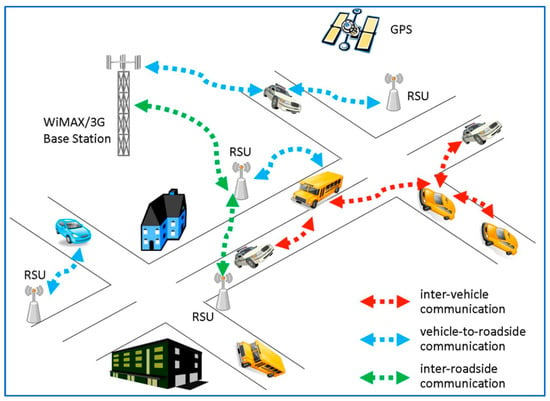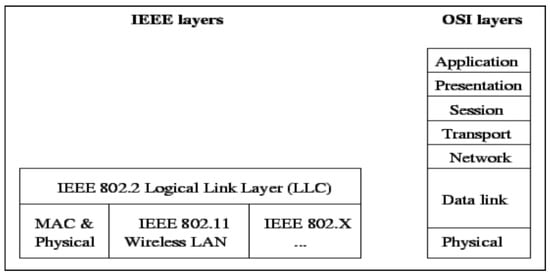You're using an outdated browser. Please upgrade to a modern browser for the best experience.
Please note this is an old version of this entry, which may differ significantly from the current revision.
Vehicular ad hoc networks (VANETs) are provided as an important component of Intelligent Transportation Systems (ITS) especially for enhancing traffic safety. The primary goal of VANETs is to improve the safety of drivers and passengers by facilitating the exchange of information between vehicles.
- vehicular ad hoc networks (VANETs)
- radio propagation models
- parking lot
- low-cost
1. Introduction
The increasing number of vehicles on the road has resulted in a rise in accidents and traffic congestion, causing significant economic losses and safety concerns. As of December 2023, the number of licensed vehicles in New Zealand is estimated to be around 4.5 million [1]. Traffic-related issues such as congestion, jams, and poor road conditions contribute to the constant threat of accidents. Vehicular ad hoc networks (VANETs) offer a potential solution for improving road safety and addressing these challenges. VANETs utilize wireless communication technology, such as Wi-Fi, to enable vehicles to communicate with each other in a point-to-point manner. Researchers have been actively working on enhancing road safety through advancements in vehicular technology and wireless communication. These VANETs have great potential to transform future vehicle applications and allow them to actively participate in communication, reducing accidents and improving the overall road conditions [2]. Road safety and efficiency can be achieved by enabling vehicle-to-vehicle (V2V) communication. The idea is to monitor the vehicle speeds and mitigate accident risks through various warning messages [3]. VANETs facilitate the exchange of safety-related information, such as traffic updates and collision warnings, to enhance road safety. The main challenges in VANET operation are due to dynamic network topology. However, IEEE 802.11-based VANETs are gaining popularity because of their cost-effectiveness and standards [4]. However, issues such as performance degradation, online management, radio channel utilization, high mobility, environmental conditions, security, and privacy are still open challenges that need to be overcome before the practical deployment of VANETs.
VANETs are provided as an important component of Intelligent Transportation Systems (ITS) especially for enhancing traffic safety [5,6,7]. The primary goal of VANETs is to improve the safety of drivers and passengers by facilitating the exchange of information between vehicles. VANETs can be considered an extreme form of mobile ad hoc networks (MANETs). While both MANETs and VANETs involve nodes communicating in an ad hoc manner without requiring fixed infrastructure, VANETs exhibit distinct characteristics [8,9]. The network topology in VANETs undergoes frequent changes due to high-speed mobility, and vehicles typically move in specific directions within the network.
Tufail, Fraser et al. [10] investigated the existing Wi-Fi protocol for Vehicle-to-Vehicle (V2V) communications in high speed environments. They demonstrated that Wi-Fi can be used for vehicular communication at high speeds and suggested some useful applications. Moreover, VANET provides massive opportunities for online vehicle entertainment such as through the local ad hoc networks sharing pictures, video, files, gaming, and chatting. Figure 1 shows a typical VANET application scenario consisting of in-vehicle and roadside sensors, their positions, intersection maps, and both-way wireless communications.

Figure 1. A typical vehicular ad hoc network (VANET) scenario.
2. VANET Applications and Classifications
VANET primarily aims to provide both safety and non-safety assistance through various applications which can be classified into two main groups: message and file delivery, and internet connectivity. Safety applications are prioritized in VANETs. However, transmission collisions can occur when multiple safety messages need to be sent simultaneously. Localization techniques can be beneficial for certain VANET applications, but accurately determining the physical location of nodes can be challenging. GPS receivers with a Geographic Information System (GIS) are commonly used for mapping location, but their accuracy (up to 20–30 m) is limited. This makes it difficult for them to work indoors or in urban environments where higher reliability and accuracy are important.
For safety-critical applications, combining GPS information with other localization techniques such as cellular localization, and image/video localization, may be necessary for enhanced accuracy and security. While VANET applications can function without localization, incorporating localization can improve the system performance when the vehicle’s position is known (Table 2).
Table 2. VANET application areas [11].
| Technique | Localization Accuracy | ||
|---|---|---|---|
| Low | Medium | High | |
| Routing | x | - | - |
| Data Dissemination | x | - | - |
| Map Localization | x | - | - |
| Coop. Adapt. Cruise Control Coop. Intersection Safety | - | x | - |
| Blind Crossing | - | x | - |
| Platooning | - | x | - |
| Vehicle Col. Warn. System Vision Enhancement | - | x | - |
| Automatic Parking | - | - | x |
| Vision Enhancement | - | - | x |
VANETs use short-range networks for vehicle communication, allowing drivers to exchange messages with neighboring drivers [16,17]. This includes exchanging information about road safety, traffic conditions, and even parking spaces. Caliskan et al. [18] investigated the costs of searching for parking spaces and also closely investigated two cars on the move searching for a parking spot [19].
3. VANET Design Issues and Challenges
Nzouonta et al. [20] discussed various issues in VANET applications, including hidden and exposed node problems, stability, scalability, reliability, and security. High mobility and rapid network topology changes in vehicular networks can impact system operations. Scalability, as well as hidden and exposed node problems, also affect the system performance. Liu, Khorashadi et al. [21] studied VANET performance under various traffic loads. Karim [22] investigated the potential of VANET for safety applications and focused on security and privacy issues. Researchers have explored various aspects of VANET, including traffic, infrastructure requirements, and security measures. Yamamoto et al. [23] developed an accident prevention technique using real-time warnings to drivers. Overall, VANETs offer promising safety applications but their security and infrastructure considerations require attention. The challenges pertaining to the security and applications of VANET have been the subject of recent studies [24,25].
4. The 802.11 Protocol for VANET
The 802.11-based Wi-Fi protocol is a part of the 802 family, including the 802.11p amendment for Wireless Access in Vehicular Environments (WAVE) [26]. The 802.11 standard primarily focuses on physical and MAC layers in the OSI model. Figure 3 shows the relationship between the 802.11 and OSI layers. The combination of the logical link control (LLC) and MAC sub-layer are known as the data link layer in the OSI model. Various versions of the 802.11 standards, such as 802.11a, 802.11b, 802.11g, and 802.11n share a common MAC and LLC layer while adopting various physical layers. Table 3 summarizes review of literature on Wi-Fi-based VANETs.

Figure 3. IEEE 802 Family of Protocols.
Table 3. Key researchers and their main contributions to Wi-Fi-based VANETs.
| Researcher | Main Contribution | Year | Key Concept/Description |
|---|---|---|---|
| Talukder et al. [27] | Investigated V2V communication. | 2022 | Analyzes the emergency alert system in case of vehicle collision. |
| Haider et al. [28] | Wi-Fi/WiMAX for VANETs | 2020 | Surveys WiMAX and WiFi for VANETs. |
| Martelli et al. [29] | VoIP performance in a IEEE 802.11p VANET | 2012 | VoIP performance in IEEE 802.11p-based VANET with on-the-field measurements. |
| Ramteke and Krishna [30] | VANET using ZigBee | 2012 | Uses AODV simulation evaluation. |
| Ho et al. [31] | VANET performance | 2012 | Analyzes protocol performance in a VANET. |
| Liu et al. [21] | Assessing VANETs under different traffic mobility | 2010 | Analyzes and formulates the “storage capability” of VMesh (one-way and highway). |
| Grilli [32] | VANET data dissemination | 2010 | 802.11g, Bluetooth, ZigBee, and WAVE. |
| Lagraa [4] | VANET clustering | 2010 | GPS localization in VANET clustering. |
| Nzouonta et al. [20] | VANET simulation | 2009 | GPS receivers, communications, and radars. |
| Buchenscheit et al. [33] | VANET Vehicle Warning | 2009 | Developed a system prototype. |
| Tufail et al. [10] | Wi-Fi-based VANETs | 2008 | Feasibility of Wi-Fi based VANETs. |
| Karim [22] | Vehicular applications | 2008 | 802.11p for roadside communication. |
| Perahia [34] | Vehicular ad hoc network | 2008 | Propagation models used in VANET. |
| Qian and Moayeri [35] | Secure VANETs | 2008 | Proposes a secure framework for VANETs. |
This entry is adapted from the peer-reviewed paper 10.3390/electronics12224672
This entry is offline, you can click here to edit this entry!
